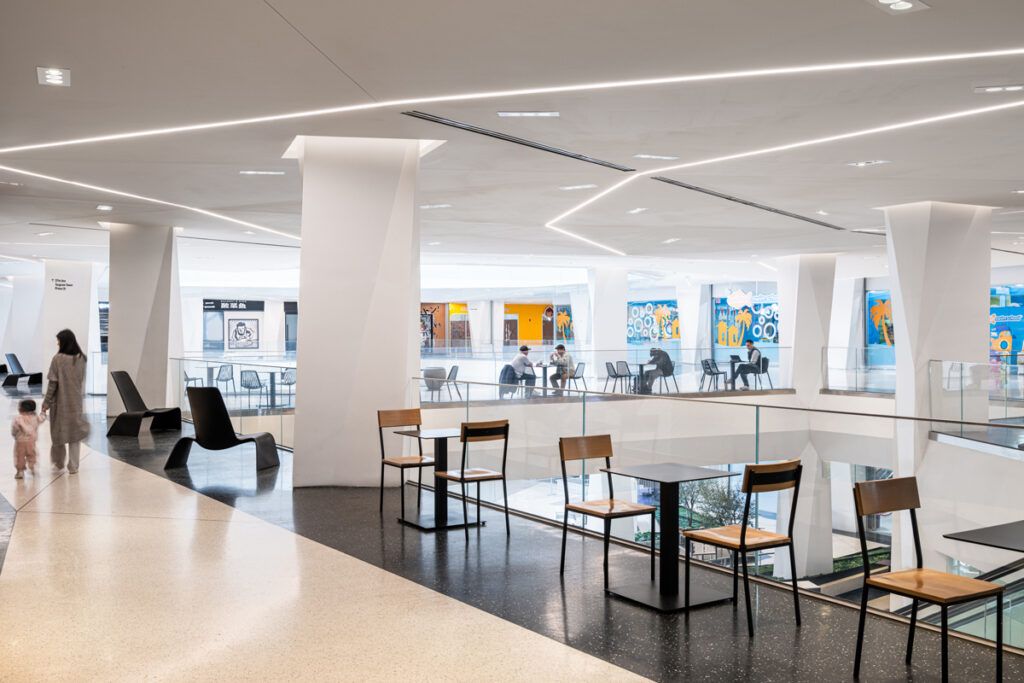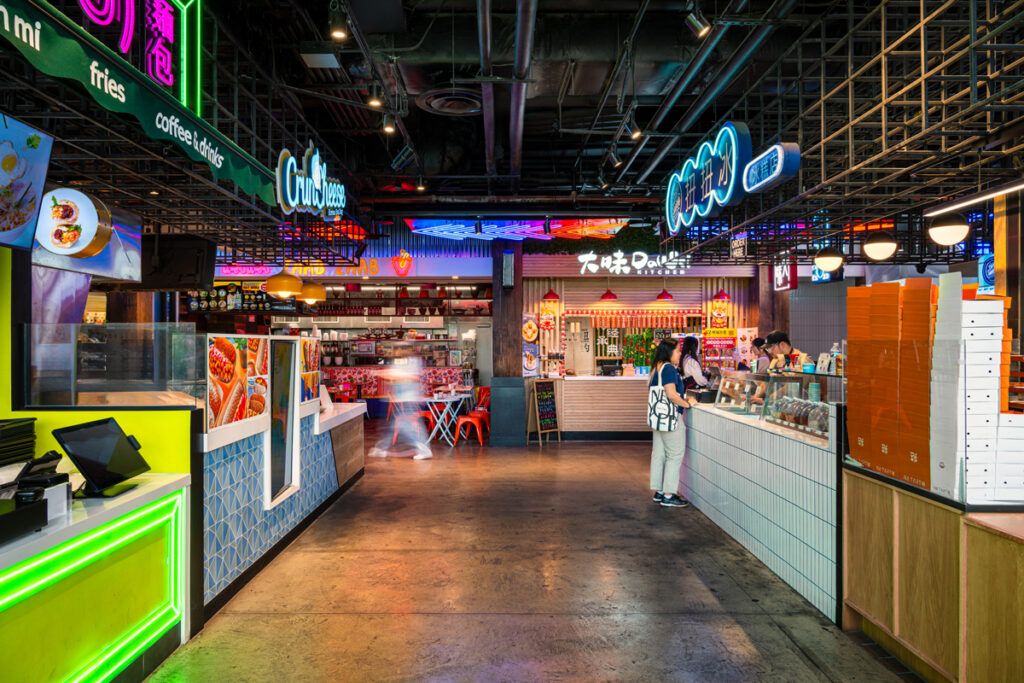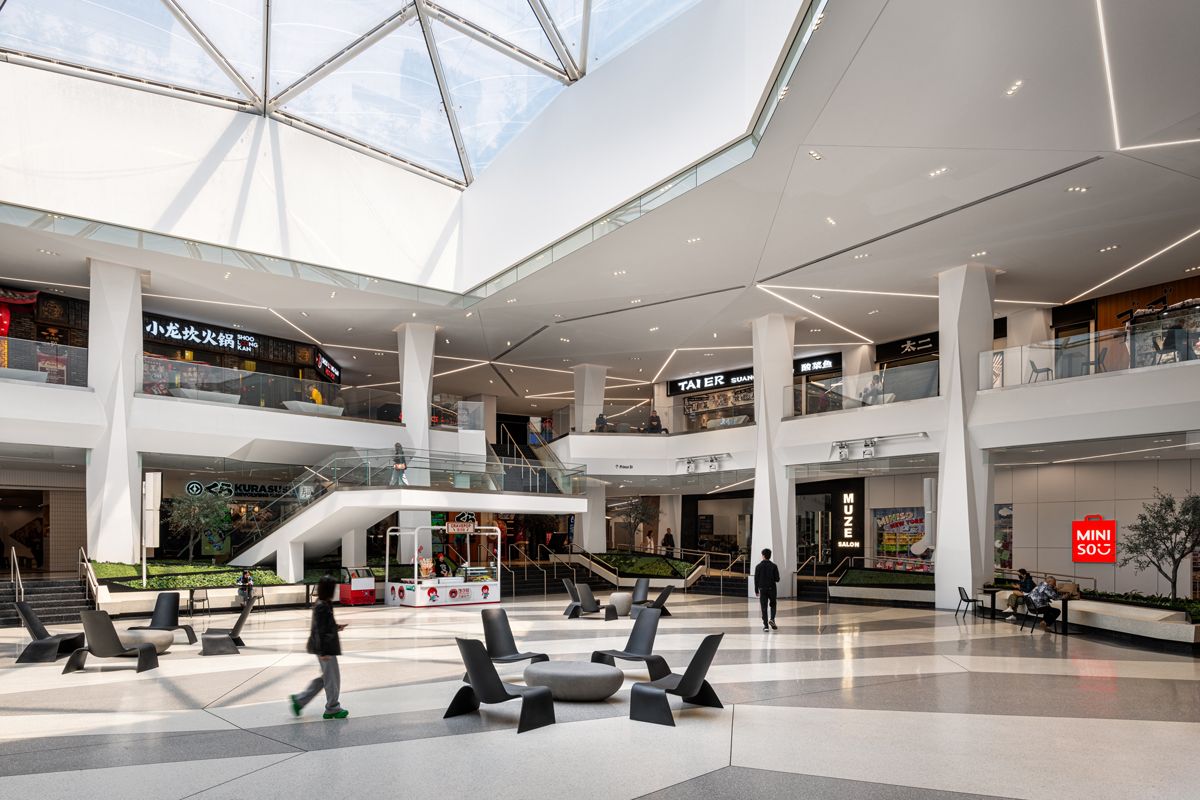When the F&T Group envisioned the Tangram Food Hall at Tangram Mall in Flushing, New York, they weren’t just looking to fill space—they wanted to capture the pulse of an ever-evolving community. Designed to mirror the dynamic energy of Asian night markets, the 24,000-square-foot food hall blends bold design moves by BHDM Design, creating a destination where flavors, cultures and experiences collide.
To bring the vision to life, they tapped BHDM Design, which delivered a space as vibrant and adaptable as the iconic tangram puzzle it’s named after. But the food hall story is more than that. With its neon signs, reclaimed materials and kinetic lighting, the space is the culmination of a decade-ago conversation. It also is a project that BHDM Principal Dan Mazzarini says reflects the synergy between retail and human engagement.
We sat down with Mazzarini to talk about the design philosophy behind Tangram Food Hall, how adaptability became a driving force in the project’s evolution and why today’s commercial spaces must be crafted with both cultural authenticity and creative flexibility in mind.
Give us a snapshot of the retail industry.
We’ve seen retail evolve from in-person to online, so the question becomes, how do we approach physical retail real estate? With places and products that require people’s presence. This can mean makeup counters, fitness centers, food and beverage locations, and coworking spaces. They all require real estate but will be driving the future of retail because they rely on human presence to operate.
What type of consumers are these projects targeting?
They target consumers of all kinds, ranging from those looking for higher-end beauty and med spas to more accessible food halls. Success is found in offerings that authentically resonate with the location’s audience.
How does the creative design of this project cater to what today’s consumers want?
This project took eight years to complete. In that time retail, the world as a whole, changed. About halfway through the process, the team had to pivot and redesign to reflect the completely reimagined retail sector in the aftermath of the pandemic. Spaces that were previously allocated for dry good vendors became food and beverage locations.
We incorporated an international approach to food, and to a lot of the mall to elevate the overall aesthetic and experience. In addition to stores and the food hall, the mall also has a swim school, orange theory, nail salon and pharmacy, all of which are activated by the human experience.
Walk us through how and why the space was designed the way it was.
There is a 16-foot height change from one side of the first floor to the other so we added a series of ramps, allowing people to completely avoid stairs if they want. We were also heavily inspired by the culture of Flushing which consists of a lively constellation of people: New York City meets Asian culture, with a strong international influence.
“Tangram” is a Chinese geometric puzzle, leveraging people as a 3D expression of the puzzle, with the overall design showcasing how these people and places intertwine and fit together. It was essential that the entire space flow together and allow all of the activities within to evolve with a changing market.

Take us through your construction and design strategy.
BHDM Design executed the master planning and interior design of the expansive first two levels of Tangram Mall, including its 24,000-square-foot food hall. We conceptualized Tangram as a modern plaza, anchoring the ever-growing community and inviting residents to immerse themselves in the rich character and spirit of one of the city’s most diverse neighborhoods.
The public space of the mall was inspired by the undulating topography of the site itself—likening it to a Tangram puzzle, we imagined the space as the 3D extrusion of puzzle pieces. Embracing these conditions, the faceted levels allow light to flood the building through expansive windows and skylights, seamlessly blending the interior with the exterior.
A curated palette of black, white and organic materials provides a neutral backdrop, allowing guests and vendors to infuse the space with their own energy. Custom fiber-reinforced columns, geometric Terrazzo flooring, and Corten planters contribute to an inspiring and timeless design, ensuring the project’s longevity.
The 24,000-square-food hall was designed to reflect the vibrancy of the Asian population of Flushing. I pulled inspiration from my travels to Asia, where I had the privilege to explore the bustling atmospheres of open-air markets in Singapore, Hong Kong, Beijing, and Taipei. The food hall planning echoes these lively environments, integrating the activation of human interaction with the visual vitality of swirling lights and signage.
As the master planners of this two-block-spanning development, we had the privilege of taking Tangram Mall from initial concept to completion, overseeing all aspects including construction, branding, furniture selection and every meaningful design detail that joins seamlessly to complete the puzzle-like property.
In the end, we were able to preserve our vibrant vision while adapting to shifts in retail and consumer behavior, all while anticipating the neighborhood’s evolving needs. With a deep sensitivity to the local context and a thoughtful approach to design, the team successfully delivered a dynamic cultural plaza that anchors the community and fosters social engagement.
What’s the biggest issue today related to the construction side of the business?
The construction part of this project was happening during the pandemic. Our main focus was really about the health and wellness of everyone involved. This continues to be the biggest obstacle: ensuring that everyone on the site is safe and protected, while still completing the project on time and to the standards of our firm and our clients.
For Tangram we were fortunate to have great construction partners who were willing to work with us on all of the challenging details that included custom panels and faceted ceilings.
Talk about sustainability. What are you incorporating in your projects?
Waste is always an issue with new projects, but sourcing close to the site allowed the team to minimize the costs of delivery and resources for shipping.

What do you see as some of your biggest opportunities moving ahead?
Adaptive reuse, second-generation spaces, and existing build-outs can be quickly renovated and brought to market. Medtech spaces are also still on the rise. As with the rest of the retail sector, the challenge remains finding new ways to entice people into the spaces.
Are you optimistic about what you see in the retail sector?
Absolutely, I’m excited about how industry shifts are shaping design aesthetics. I think there are more reasons to be optimistic than not; online shopping changed everyone and people are certainly different now, but they still find value in retail experiences that require person-to-person interaction.
We also live in a world of sameness now, so people are becoming excited by mom-and-pop stores again and the idea of only being able to get a product or experience from this one location. There is beauty in curation and being able to go to a vendor who is a specialist in whatever it is they sell.
What trends are you seeing?
In order to stand out, everything requires the physical presence of sales associates and elevated service, as well as customization. People want to feel that if they are leaving their homes and choosing to shop at a brick-and-mortar location; they want to get more out of it than a simple shopping experience.
What is the secret to creating a “must-visit” retail experience today?
Customization, bespoke interaction, experiential design and an ephemeral experience.
What is today’s consumer looking for?
Unique products and high value. Is what they are buying worth the investment, will it serve the purpose they need it to and for long enough that they don’t feel like they are constantly replacing it? Here is where the merchant idea comes into play because the experts selling these products are able to offer intel and recommendations that you can’t get from online retail.
Tell us what makes your brand unique.
Our team always anticipates needs and exceeds expectations. All of our designs are bespoke and so are the narratives behind them. We work with our partners to pinpoint the story they want to tell the world and how that translates into the physical space.
We have experience in every sector, but our background is rooted in retail and we have found that if you can design a brand, you can help brand the lifestyle associated with it, which is what really resonates with people.
Story by Michael J. Pallerino, editor of Commercial Construction & Renovation magazine. Over the past 30-plus years, he has won numerous awards, including the “Jesse H. Neal Editorial Achievement Award,” recognized as the Pulitzer Prize for business-to-business magazines. He can be reached at [email protected].
Describe a typical day.
I’m an early bird so I start my day by going to the gym, getting a coffee, and getting in the office before 9 a.m. I prefer to work through things over calls, not as often through emails, so my days are filled with meetings. The rest of my day consists of just about anything you can imagine from working with my team and keeping our heads down in design schemes.
After we wrap up for the day I usually eat dinner at one of my many favorite restaurants in the city because, while I love to cook, I don’t prefer to cook in my apartment kitchen. Then it’s bed before 10 p.m. to be up to do it all again the next day.
What’s the biggest thing on your to-do list right now?
I have a lot of travel coming up and I really want to find vendors that offer exciting experiences. If you have a Louis Vuitton passport holder and go to one of their locations in any given city, they will stamp it for you.
It’s a high-end experience that you can replicate throughout your travels and have something unique to remember them by. I want to find other retailers, big and small, that have similar offerings that will make me remember their store and the unique interaction I had there.
What was the best advice you ever received?
Do something you love enough that you’re willing to do it for free, then do it well enough that someone is willing to pay you.
What’s the best thing a client ever said to you?
The best response is silence. Some clients get overwhelmed by the reveal moment, so not receiving notes or feedback can actually be the biggest compliment.
View the original article and our Inspiration here


Leave a Reply